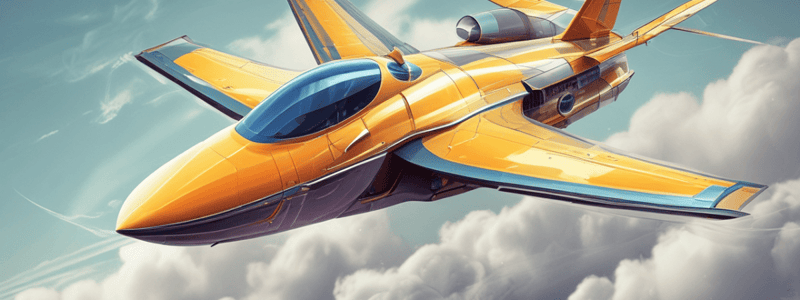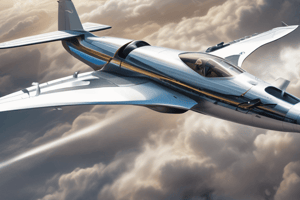Podcast
Questions and Answers
What is the primary challenge pilots face when operating at high altitudes?
What is the primary challenge pilots face when operating at high altitudes?
- Reduced engine performance and lift (correct)
- Increased air density
- Decreased air resistance
- Increased viscosity
How does the thinning air at higher altitudes affect aircraft performance?
How does the thinning air at higher altitudes affect aircraft performance?
- It increases lift but decreases power
- It increases lift and power
- It decreases lift and power (correct)
- It has no effect on lift and power
What is the primary role of pilots in managing aircraft performance?
What is the primary role of pilots in managing aircraft performance?
- To navigate through turbulent air
- To compensate for changes in air density (correct)
- To reduce friction and viscosity
- To optimize engine performance
What is the boundary layer, and how does it impact aircraft performance?
What is the boundary layer, and how does it impact aircraft performance?
What is the primary effect of friction on aircraft performance?
What is the primary effect of friction on aircraft performance?
What is the ultimate goal of pilots and aircraft designers in managing aerodynamic principles?
What is the ultimate goal of pilots and aircraft designers in managing aerodynamic principles?
What is the relationship between air density and altitude?
What is the relationship between air density and altitude?
What is the primary effect of viscosity on aircraft performance?
What is the primary effect of viscosity on aircraft performance?
What is the primary role of the standard atmosphere model in aircraft performance?
What is the primary role of the standard atmosphere model in aircraft performance?
What is the primary challenge in managing friction on aircraft surfaces?
What is the primary challenge in managing friction on aircraft surfaces?
The decrease in air density with altitude always results in increased engine performance.
The decrease in air density with altitude always results in increased engine performance.
Viscosity has no impact on lift and drag.
Viscosity has no impact on lift and drag.
Pilots need to adjust only engine settings to compensate for high-altitude operations.
Pilots need to adjust only engine settings to compensate for high-altitude operations.
Friction always results in parasitic drag.
Friction always results in parasitic drag.
The standard atmosphere model is used to predict weather patterns.
The standard atmosphere model is used to predict weather patterns.
The thinning air at higher altitudes provides more resistance.
The thinning air at higher altitudes provides more resistance.
Air density remains constant regardless of altitude.
Air density remains constant regardless of altitude.
Reducing friction has no impact on aircraft performance.
Reducing friction has no impact on aircraft performance.
The boundary layer affects only drag.
The boundary layer affects only drag.
Aerodynamic principles are only important during takeoff and landing.
Aerodynamic principles are only important during takeoff and landing.
What aerodynamic principle is responsible for the reduction in lift and power as an aircraft ascends?
What aerodynamic principle is responsible for the reduction in lift and power as an aircraft ascends?
What two factors contribute to the development of the boundary layer, affecting lift and drag?
What two factors contribute to the development of the boundary layer, affecting lift and drag?
What is the primary purpose of the standard atmosphere model in aircraft performance?
What is the primary purpose of the standard atmosphere model in aircraft performance?
What is the ultimate goal of pilots and aircraft designers in managing aerodynamic principles?
What is the ultimate goal of pilots and aircraft designers in managing aerodynamic principles?
What two forces must pilots continually assess and respond to in order to maintain control and efficiency during flight?
What two forces must pilots continually assess and respond to in order to maintain control and efficiency during flight?
What is the primary effect of reducing friction on aircraft surfaces?
What is the primary effect of reducing friction on aircraft surfaces?
What is the relationship between air density and the development of lift and drag?
What is the relationship between air density and the development of lift and drag?
What is the primary role of pilots in managing aircraft performance during high-altitude operations?
What is the primary role of pilots in managing aircraft performance during high-altitude operations?
What is the ultimate consequence of failing to manage aerodynamic principles during flight?
What is the ultimate consequence of failing to manage aerodynamic principles during flight?
What is the primary benefit of understanding the relationship between air density and altitude?
What is the primary benefit of understanding the relationship between air density and altitude?
Flashcards are hidden until you start studying
Study Notes
Aerodynamics in Aviation
- Aerodynamics play a pivotal role in aviation safety and performance, enabling pilots to navigate the skies safely and efficiently.
- Understanding aerodynamic principles is critical for pilots to adapt to ever-changing flight conditions and challenges.
Forces of Flight
- Gravity is an omnipresent force that constantly acts on an aircraft, pulling it towards the Earth.
- Lift is required to counteract gravity, and it is generated by the aircraft's velocity, airfoil shape, and surrounding air density.
- Thrust and drag are two additional forces that work in opposition during flight, with thrust propelling the aircraft forward and drag slowing it down due to air resistance.
Lift and Aerodynamic Efficiency
- The principles of lift are central to an aircraft's ability to ascend, cruise, and maneuver.
- Lift occurs when the pressure below the wing becomes greater than the pressure above it, influenced by Bernoulli's principle and Newton's third law of motion.
- Changing the angle of attack, wing shape, and aircraft speed can directly affect the amount of lift generated, enabling pilots to climb, descend, and turn the aircraft.
Atmospheric Conditions
- The atmosphere is composed of various layers, including the troposphere, stratosphere, and mesosphere, each with distinct characteristics such as temperature, pressure, and air composition.
- Air density decreases with altitude, affecting engine performance and lift, and requiring adjustments to flight plans and engine settings.
- Understanding the standard atmosphere model and its relation to aircraft performance is a necessary skill for pilots.
Viscosity and Friction
- Viscosity and friction influence airflow around an aircraft, with effects that can be both beneficial and detrimental.
- Viscosity contributes to the development of the boundary layer, impacting lift and drag.
- Managing friction, which can lead to parasitic drag, requires a smooth aircraft surface and streamlined shape.
Practical Application of Aerodynamics
- Pilots must recognize how gravity's unyielding pull affects everything from takeoff to landing, necessitating continuous adjustments to the aircraft's controls and power settings.
- Efficient flight operations involve maximizing thrust while minimizing drag, a balance that depends on the aircraft's design, speed, and atmospheric conditions.
- Mastery of aerodynamic concepts allows pilots to optimize aircraft performance, ensuring safe and efficient flight across a range of conditions.
Aerodynamics in Flight Scenarios
- Gravity is an omnipresent force that constantly pulls aircraft towards the Earth, requiring pilots to generate enough lift to counteract it during takeoffs, climbs, and cruising.
- Gravity's effect is essential to recognize in various phases of flight, including takeoffs, climbs, cruising, and descents.
Thrust and Drag Forces
- Thrust is the forward force produced by the aircraft's engine(s), vital for takeoff and maintaining airspeed.
- Drag is the resistance an aircraft experiences as it moves through the air, opposing the thrust force.
- In cruising at altitude, pilots must maintain sufficient thrust to balance the drag, ensuring a steady flight without unnecessary fuel consumption.
Lift Production and Practical Examples
- Lift, generated primarily by the wings, allows an aircraft to leave the ground and is critical for flight.
- In turbulence, airflow around the wings fluctuates, causing variations in lift and, consequently, altitude.
- Skilled pilots must adeptly manage the aircraft's speed and angle of attack to maintain steady lift, ensuring passenger safety and comfort.
Aerodynamics in Real-World Scenarios
- Understanding aerodynamic principles is critical for safe and efficient flight, as demonstrated in real-world case studies.
- Aerodynamics plays a pivotal role in aviation safety and performance, influencing flight conditions and challenges.
Case Studies: Aerodynamics in Action
- A historical incident involved an aircraft encountering an unexpected drop in air density while cruising above the tropopause layer, leading to a loss of engine performance and altitude.
- Understanding atmospheric stratification and air density variability due to altitude is essential for pilots to anticipate and respond to such issues.
- Historical flight records and milestones, such as breaking altitude records, demonstrate the importance of accounting for air density changes with altitude.
- Excessive skin friction on aircraft wings at high speeds led to a drastic increase in drag, highlighting the significance of air viscosity and friction.
- Boundary-layer control techniques can reduce friction and enhance aerodynamic efficiency.
Atmospheric Conditions and Aerodynamics
- The atmosphere is composed of various layers, each with distinct characteristics, including temperature, pressure, and air composition.
- Air density, which diminishes with altitude, plays a pivotal role in flight dynamics, requiring pilots to compensate for these changes.
- Understanding the standard atmosphere model and its relation to aircraft performance is a necessary skill for pilots.
- Viscosity and friction influence airflow around an aircraft, with effects that can be both beneficial and detrimental.
Aerodynamics in Flight
- Gravity is an omnipresent force that constantly pulls an aircraft towards the Earth, requiring lift to counteract it.
- Lift is generated by the wings and is affected by the aircraft's velocity, wing shape, and surrounding air density.
- Pilots must recognize how gravity affects flight, necessitating continuous adjustments to controls and power settings to maintain desired flight paths.
Thrust and Drag
- Thrust is the forward force produced by the aircraft's engines or propellers, propelling the aircraft forward.
- Drag is a resisting force, slowing the aircraft down due to air resistance.
- Pilots must manage these forces to achieve and maintain the required speed for different phases of flight.
Lift and Airfoil Design
- Lift occurs when the pressure below the wing becomes greater than the pressure above it, influenced by Bernoulli's principle and Newton's third law of motion.
- Changing the angle of attack, wing shape, and aircraft speed can directly affect the amount of lift generated.
- This control enables pilots to climb, descend, and turn the aircraft as required.
Atmospheric Conditions
- The atmosphere is composed of various layers (troposphere, stratosphere, mesosphere, etc.), each with distinct characteristics (temperature, pressure, air composition) affecting flight safety and performance.
- Air density, which decreases with altitude, plays a pivotal role in flight dynamics, requiring adjustments to flight plans and engine settings.
Case Studies and Applications
- Understanding atmospheric stratification and air density variability is crucial for anticipating and responding to issues during flight.
- The application of boundary-layer control techniques can reduce friction and enhance aerodynamic efficiency.
- Design improvements, such as winglets, minimize vortices and drag by capitalizing on an understanding of air viscosity and flow patterns.
Importance of Aerodynamics
- Aerodynamics is a lifesaving, performance-enhancing science that makes modern aviation possible.
- Every diagram and calculation has real connotations in the skies, directly affecting flight safety, efficiency, and environmental impacts.
- Understanding the practical application of aerodynamic principles is vital for pilots to optimize aircraft performance, ensuring safe and efficient flight across a range of conditions.
Studying That Suits You
Use AI to generate personalized quizzes and flashcards to suit your learning preferences.




